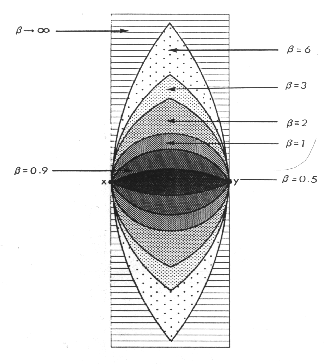 -Neighbours
-Neighbours -neighbours in the set
S if N(x,y,
-neighbours in the set
S if N(x,y, ) contains no point of S, other than x or y, in its
interior. There are various kinds of definitions of N(x,y,
) contains no point of S, other than x or y, in its
interior. There are various kinds of definitions of N(x,y, ). One of
them is called Lune-Based Neighbourhoods.
). One of
them is called Lune-Based Neighbourhoods.

Lune-Based Neighbourhoods

 ) for various
) for various  >0
>0

 1
1
We difine N(x,y, ) to be the intersection of the two circles of
radius
) to be the intersection of the two circles of
radius  d(x,y)/2 centered at the points (1-
d(x,y)/2 centered at the points (1-  /2)x+(
/2)x+( /2)y and
(
/2)y and
( /2)x + (1-
/2)x + (1-  /2)y, respectively.
/2)y, respectively.
When  =1, N(x,y,
=1, N(x,y, ) corresponds exactly to
the Gabriel neighbourhood
of x and y. When
) corresponds exactly to
the Gabriel neighbourhood
of x and y. When  =2, we get the ``relative neighbourhood'' of the RNG.
As
=2, we get the ``relative neighbourhood'' of the RNG.
As  approaches
approaches  , the neighbourhood of x and y approximates the
infinite strip formed by translating the line segment (x, y) normal to itself.
, the neighbourhood of x and y approximates the
infinite strip formed by translating the line segment (x, y) normal to itself.


 [0,1]
[0,1]
We difine N(x,y, ) to be the intersection of the two circles of radius
d(x,y)/(2
) to be the intersection of the two circles of radius
d(x,y)/(2 ) passing through both x and y. When
) passing through both x and y. When  =1, this is
consistent with the definition abvove. As
=1, this is
consistent with the definition abvove. As  approaches 0, N(x,y,
approaches 0, N(x,y, )
approximates the line segment joining x and y. Thus, except in degenerate
situations (three or more points colinear), all point pairs are
)
approximates the line segment joining x and y. Thus, except in degenerate
situations (three or more points colinear), all point pairs are
 -neighbours under this scheme for
-neighbours under this scheme for  sufficiently small.
sufficiently small.
 go back to Beta Skeleton
go back to Beta Skeleton  go back to Home
go back to Home 
 Xiaoming ZHONG
Xiaoming ZHONG